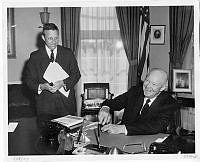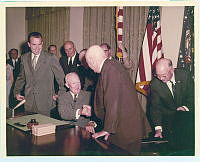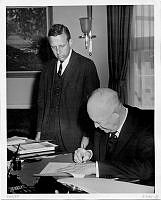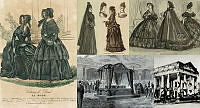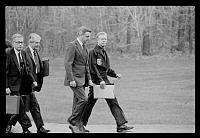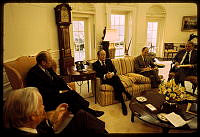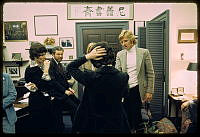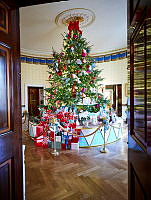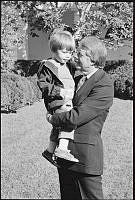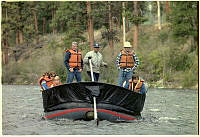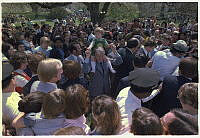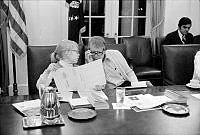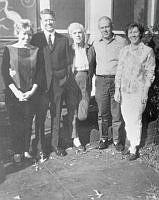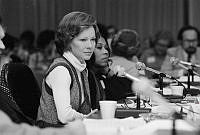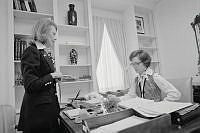Eliza Johnson

Eliza McCardle was born on October 4, 1810. According to the Johnson family bible, Eliza’s birthplace was Greeneville, Tennessee; however, other sources claim she was born elsewhere in the state.1 Eliza’s father, John McCardle, was a shoemaker of Scottish descent. Her mother, Sarah Phillips McCardle, managed the household, and her ancestors may have come from Plymouth, Massachusetts.2
Eliza’s father died shortly after her birth, leaving Sarah to raise their infant daughter. Eliza and her mother moved to Greeneville where Sarah married Moses Whitesides, a silversmith or watchmaker from Asheville, North Carolina.3 Eliza’s parents sent her to a girls’ school where she studied reading, spelling, grammar, arithmetic, geography, history, philosophy, and needlework.4
While attending school, Eliza met Andrew Johnson, an aspiring tailor looking to set up a new shop in town.5 Andrew and Eliza were married on May 17, 1827.5 They had five children—Martha, Charles, Mary, Robert, and Andrew Johnson, Jr.6
Eliza instructed her husband on grammar, handwriting, and speech. Eliza is often credited with contributing to her husband’s political success.7 The Johnsons also purchased several enslaved individuals to work as servants in their Greeneville home. It is likely that Eliza managed her enslaved servants.8
When President Abraham Lincoln was assassinated in 1865, Andrew Johnson became president of the United States. Eliza and her entire extended family, including freed servants, moved into the White House.9
Eliza’s tuberculosis limited her daily activities as first lady. Eliza delegated many of her responsibilities to her daughters, Martha, and Mary. Eliza also found attending social events at the Executive Mansion too challenging for her health. She spent most of her time in her private quarters reading and sewing.10
After the end of President Johnson’s term, Eliza returned to Tennessee. She died six months after the death of her husband on January 15, 1876, at her daughter Mary’s farm in Carter County. Eliza was buried next to Andrew on a hill overlooking Greeneville, now part of the Andrew Johnson National Cemetery.11
Footnotes & Resources
- According to research completed by lead historians and National Park Service at the Johnson Family National Historic Site, there are many possible birthplaces for Eliza McCardle Johnson, including Leesburg, Greeneville, and Telford, Tennessee. The family bible logs her birthplace as Greeneville, but a marker at the United Methodist Church in Telford indicates that Eliza’s grandfather, Phillip McCardle, donated one acre of land where Eliza was born to the Methodist Episcopal Church to erect a meeting house and cemetery. Telford was not named Telford until 1855. It was named Telford Depot for Colonel George Whitfield Telford who donated four acres to support local operations of the East Tennessee and Virginia Railroad. Before then it was known as Millwood. Leesburg and Telford are very close to each other. The Leesburg Road runs off one side of the current 11E; Telford Road runs from the other. Just above them is the McCarty Church Road and McCarty Hollow Road. This property sits north of and in between the two cities.
- Andrew Johnson and E. McCardle Ancestry, Accelerated Indexing Systems, Inc. Salt Lake City, Utah.
- Harry B. Roberts, Olden Times in Green County, Vol I, 1983. P. 16; Glenna R. Schroeder and Richard Zuczek, “Eliza Johnson,” Andrew Johnson, A Biographical Companion, ABC Clio, Santa Barbra, California, 2001, pp. 164-165; Sol Barzman, The First Ladies, New York, Cowles Book company, Inc., 1970. P. 152; Martha Johnson Patterson, Copy of Memorandum made by Mrs. Martha J. Patterson made shortly before her death. April 9, 1901.
- Richard Harrison Doughty, Greenville: One Hundred Year Portrait (1775-1875), Richard Harrison Doughty, Greenville, Tennessee, 1975, p. 186. It is thought that Eliza McCardle attended the Rhea Academy according to Carl Sterrazza, First Ladies: The Saga of the Presidents’ Wives and Their Power, 1789-1961, (New York: William Morrow and Company, 1990), 203-205.
- Jean Choate, Eliza Johnson in Perspective, A Volume in the Presidential Wives Series, (New York: Nova History Publications, 2001), 7-8; Richard Harrison Doughty, Greenville: One Hundred Year Portrait (1775-1875), Richard Harrison Doughty, Greenville, Tennessee, 1975, p. 59; Brabson Papers. University of Tennessee Archives, Box 5.
- Andrew Johnson’s Family, National Park Service, National Historic Site Tennessee. Andrew Johnson's Family - Andrew Johnson National Historic Site (U.S. National Park Service) (nps.gov)
- Record Books, Andrew Johnson Papers, Huntington Library.
- David Warren Bowen, Andrew Johnson and the Negro, (Knoxville: The University of Tennessee Press, 1989), 51.
- Eliza McCardle Johnson, The American Presidency Project, UC Santa Barbara. (17) Eliza McCardle Johnson | The American Presidency Project (ucsb.edu); “The Moses of the Colored Men Speech,” in David Warren Bowen, Andrew Johnson and the Negro, 80.
- William Seale, The President’s House: A History, Vol. 1, (Washington: The White House Historical Association, 1986), 415; Betty C. Monkman, The White House: Its Historic Furnishing and First Families, Second Edition, (New York: Abbeville Press Publishers, 2014), 133-135; Eliza McCardle Johnson, The American Presidency Project, UC Santa135; French Diary, February 24, 1867, French Papers; Hans L. Trefousse, Andrew Johnson, A Biography, (New York: W. Norton & Company, 1989), 285.
- Choate, Eliza Johnson in Perspective, 154.








